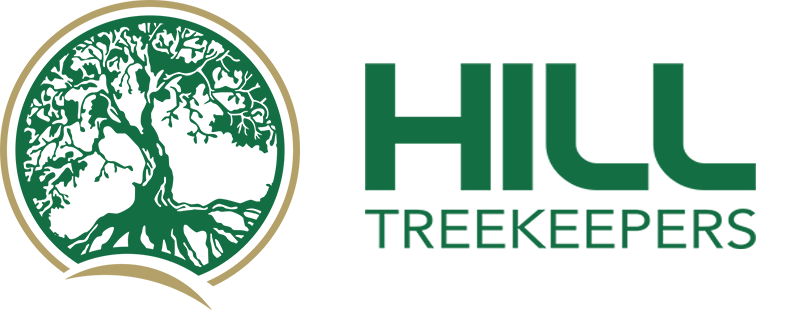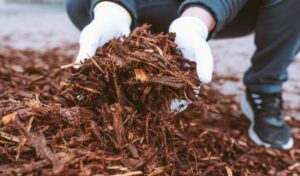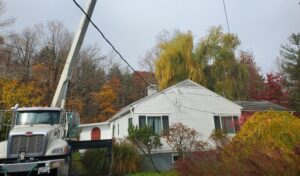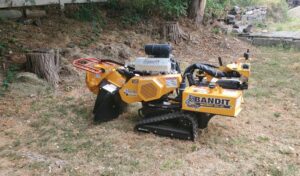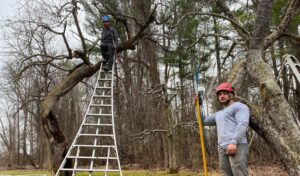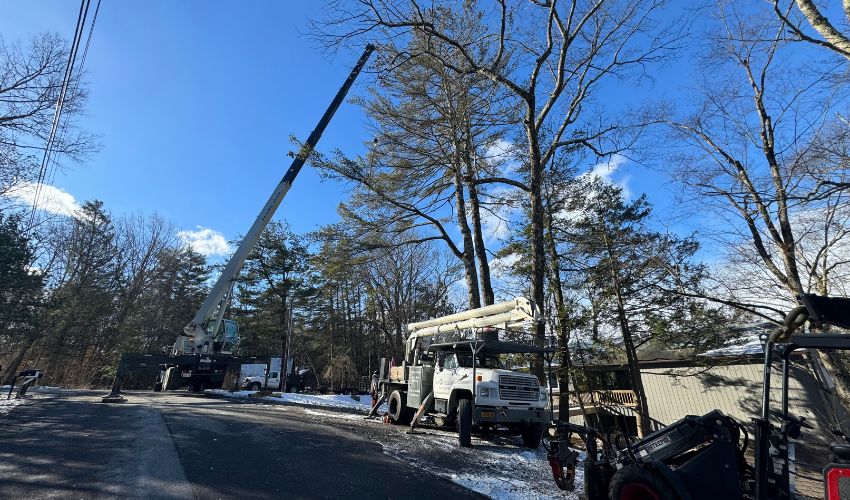
Trees add beauty and value to our communities, but there are times when they need to be removed, especially when they pose risks to our properties and safety. In the Hudson Valley region, particularly in towns like Newburgh and Saugerties, NY, difficult tree removal jobs present unique challenges. Whether it’s a tree nestled between historic homes, growing precariously close to power lines, or situated in a narrow alleyway, the complexity of such removals may lead you to think that it’s not possible to take down a tree. However, these seemingly daunting tasks can be performed safely and efficiently if you hire a professional tree removal company with the right expertise, equipment, and safety measures to perform difficult tree removal jobs.
Key Takeaways
- Trees in difficult-to-access areas require specialized removal techniques to ensure safety and prevent damage to historic structures and landscapes.
- Certified Arborists use methods like sectional removal, cranes, rigging, and aerial lifts to navigate the unique challenges of tree removal in Hudson Valley’s narrow spaces and historic districts.
- Professional tree removal services possess the necessary knowledge, equipment, and training to manage complex removals while adhering to local environmental and legal regulations, as well as safety standards.
- Entrusting difficult tree removal to a professional tree service company like Hill Treekeepers ensures that the job will be done safely.
Why are some trees in the Hudson Valley more difficult to remove than others?
In the picturesque Hudson Valley, where the historic charm of Newburgh and the scenic beauty of Saugerties blend with the rugged backdrop of the Shawangunk Ridge and the serene waters of the Hudson River, trees play a vital role in the landscape.
However, the features that add to the region’s allure also contribute to complex scenarios when those trees must be removed. “Difficult tree removal” refers to situations where trees are situated in locations that significantly complicate their safe extraction.
These challenges often arise due to the tree’s proximity to valuable structures, its location in narrow or hard-to-access spaces, or the area’s unique geographic and architectural features.
In Newburgh, NY, and surrounding areas, examples of difficult tree removal situations abound:
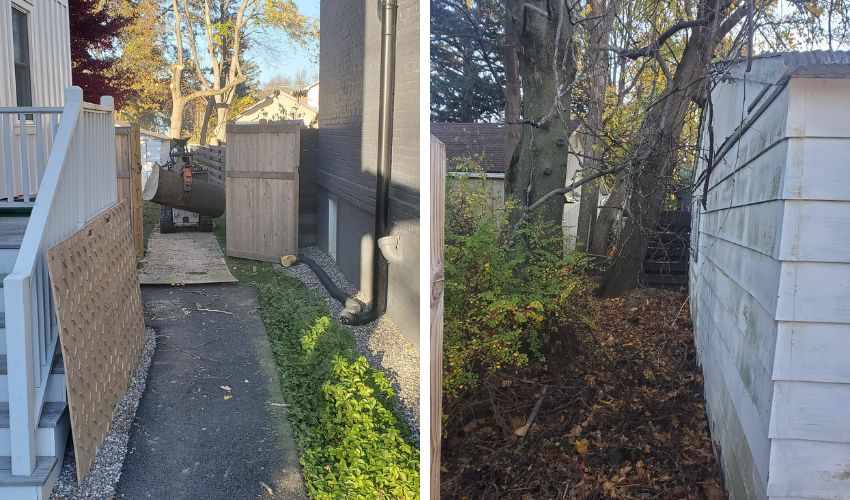
Mastering Tight Spaces: Our dedicated crew at Hill Treekeepers demonstrates their expertise in a Newburgh alley, ensuring a seamless and safe tree removal process.
Narrow Alleyways
Newburgh’s dense, historic layout includes many federal-style houses with narrow alleyways between buildings. These tight spaces restrict access to heavy machinery needed to remove large trees, requiring specialized techniques and equipment to safely take down trees.
Historic Homes
Many towns in the Hudson Valley have historic homes or historic districts, with yards that offer limited space for maneuvering. Removing a tree without disturbing the historic charm or causing damage to these cherished properties demands a high degree of precision and expertise.
Furthermore, many of these properties have architectural features like skylights, swimming pools, and ornate fencing, creating additional concerns and challenges.
To make removal in historic districts even more complex, there are permits required before work can begin. Property owners cannot remove a tree greater than eight inches in diameter, measured 54 inches from the base of said tree, in a historic district without having a tree removal permit approved by the Superintendent of Public Works.
Proximity to Structures and Power Lines
The Hudson Valley is known for its historic homes, barns, and other structures, many of which are in close proximity to large, mature trees and power lines. The risk of damage to these properties during tree removal is a significant concern, necessitating careful planning and execution.
Topographical Challenges
The topographic features of the area also play a role in complicating tree removal efforts. The rolling hills and rugged terrain of places like the Catskill Mountains and the Shawangunk Ridge can make access difficult, while the proximity to water bodies like the Hudson River adds environmental considerations.
Whether it’s a towering pine teetering on the edge of a steep slope or an ancient oak nestled among historic cottages, each tree removal scenario requires a nuanced approach that balances safety, environmental stewardship, and the preservation of local heritage.
Difficult tree removal, therefore, is not just about the technical act of cutting down a tree – it’s also about understanding and respecting the complex interplay of nature, history, and community that defines the Hudson Valley.
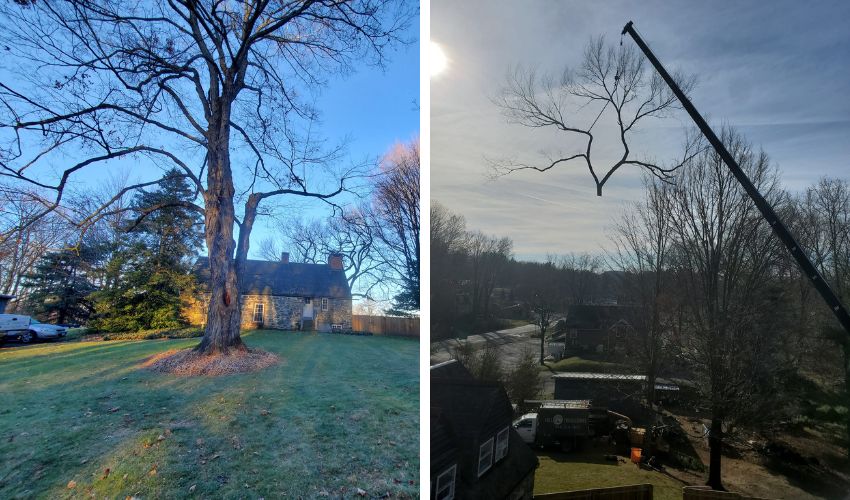
Preserving Heritage, Protecting Nature: Removal of an American Elm at Gardiner’s Majestic House, fallen victim to Dutch Elm Disease. With precision and respect, our team ensured its safe removal, protecting the Majestic House’s legacy and the beauty of our Hudson Valley.
Techniques for Difficult Tree Removal
Removing trees from challenging environments, especially in densely populated or ecologically sensitive areas like Newburgh, NY, and its surrounding Hudson Valley region, required a blend of skill, precision, and advanced technology. Professional tree service companies, like Hill Treekeepers, employ various techniques to ensure the safe and effective removal of trees in such difficult circumstances.
Before hiring a tree service company, discuss with their arborist how they plan to remove your tree. They should be able to explain exactly which techniques and equipment will be used, why, and how that will protect your home and property.
An experienced tree removal provider will use one or more of the following methods to take down trees in challenging locations or situations:
Sectional Removal (Piece-by-Piece Dismantling)
This method involves carefully cutting the tree into smaller, manageable sections, safely lowered to the ground using ropes or cranes. This technique is particularly useful in tight spaces or when the tree is near buildings, power lines, or other sensitive areas. The process minimizes the risk of damage to surrounding properties and allows for greater control over the removal.
Cranes for Lifting
When access is severely restricted or a tree’s size and location pose significant risks to nearby structures, cranes are used to lift sections of the tree out of the area. This approach is especially effective for trees on steep inclines, over buildings, or in backyard spaces where traditional methods are not feasible. Using cranes can significantly reduce the time and labor involved in tree removal and enhance safety.
Rigging and Ropes
Advanced rigging techniques are employed to control the descent of tree limbs and sections as they are cut. This method is essential for preventing uncontrolled falls that could lead to injury or property damage. Skilled arborists use a combination of ropes, pulleys, and braking devices to ensure that each piece is securely guided to the ground in a controlled manner.
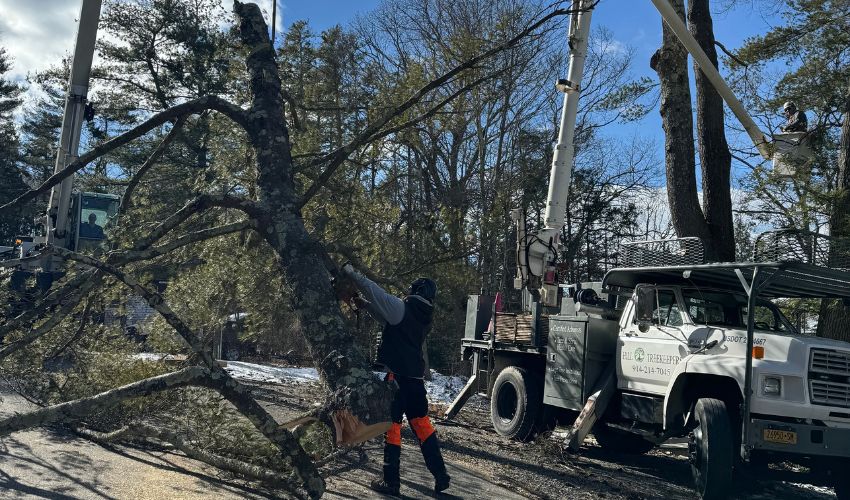
Reaching New Heights: Our team in action, employing a bucket truck for meticulous tree care and removal. Ensuring every branch is handled with expertise, for the health of the tree and safety of our community.
Aerial Lifts and Bucket Trucks
When cranes are unsuitable for the job, aerial lifts and bucket trucks provide arborists with the mobility to reach high branches safely. These vehicles are particularly useful for navigating obstacles and performing precise cuts without putting the tree workers at undue risk.
Understanding these techniques for residents and property managers in Newburgh and the Hudson Valley underscores the importance of hiring professional, certified arborists for tree removal projects. Not only do these professionals possess the skills and equipment necessary for difficult tree removals, but they also bring a commitment to safety and environmental stewardship to each project, ensuring that the beauty and integrity of the region are preserved.
The Essential Role of a Professional Tree Removal Company in Difficult Tree Removal
When facing the complexity of removing trees from challenging locations in Newburgh, NY, and the surrounding Hudson Valley area, the expertise of professional tree service providers becomes indispensable. The intricacies of such operations go beyond mere physical removal, demanding a comprehensive understanding of arboriculture, safety protocols, and local environmental regulations.
Here’s why professional expertise is not just beneficial but crucial for difficult tree removal:
Specialized Knowledge and Experience
Certified Arborists and experienced tree removal specialists bring a depth of knowledge about various tree species, their growth patterns, and potential diseases. This expertise is vital for accurately assessing the health and stability of a tree and determining the safest method for its removal, especially in tight spaces or near valuable properties.
Access to Specialized Equipment
Professional tree services are equipped with the specialized tools and machinery to safely and efficiently remove trees in difficult locations. From cranes and aerial lifts to stump grinders and state-of-the-art safety gear, having the right equipment is essential for minimizing the risk of damage to surrounding structures and ensuring the safety of both the workers and the public.
Safety Standards and Training
The inherent risks of tree removal, particularly in complex scenarios, cannot be overstated. Professionals are trained in the latest safety protocols and equipped to handle emergencies, ensuring the removal process is conducted with the utmost care to prevent accidents and injuries.
Compliance with Local Regulations
Understanding and adhering to local environmental regulations and obtaining the necessary permits for tree removal is a complex process. Professionals are familiar with the regulatory landscape of the Hudson Valley, ensuring that all tree removal activities are compliant, thus protecting property owners from potential fines and legal complications.
Environmental Stewardship
Beyond removal, professional arborists consider the ecological impact of their work, striving to preserve the natural beauty and biodiversity of the Hudson Valley. They can provide guidance on replacement planting and other practices to maintain the area’s ecological balance and aesthetic appeal.
Frequently Asked Questions
Q. Can a tree be removed if it’s not currently posing a direct threat but may in the future?
A. Yes, a tree can be preemptively removed if an assessment determines it poses a potential future threat due to its condition, location, or other risk factors, ensuring long-term safety and property protection.
Q. What is the best time of year to remove a tree?
A. While tree removal can be performed year-round, the best time often depends on the tree species and the reason for removal. Winter, when trees are dormant, is generally considered optimal for many species due to decreased risk of disease transmission and less impact on the surrounding landscape.
Q. How long does the tree removal process typically take?
A. The duration of tree removal varies based on the tree’s size, location, and complexity of the removal. Simple tasks may take a few hours, while more complex situations could require a full day or more.
Q. What happens to the tree once it’s removed?
A. Removed trees are typically cut into manageable sections and can be processed into mulch, firewood, or lumber, depending on the condition of the wood and the homeowner’s preference. Recycling or repurposing the wood is encouraged to minimize waste.
Q. How do professionals determine the cost of removing a difficult tree?
A. The cost is determined based on several factors, including the tree’s size, location, access difficulty, potential risks, and the equipment and manpower required. An on-site assessment by the tree service provider is typically necessary to provide an accurate quote.
Preserving the Beauty and Safety of the Hudson Valley
The majestic landscapes and historic towns of the Hudson Valley, including Newburgh, NY, are treasures that require careful stewardship. When removing trees from difficult locations becomes necessary, entrusting the task to professionals ensures the safety and integrity of the immediate environment and the preservation of this region’s unique heritage.
For homeowners, property managers, and municipalities, the decision to remove a tree, especially one that poses a challenge due to its location or condition, should be guided by the expertise of certified arborists. These professionals bring a commitment to safety, environmental responsibility, and community well-being to every project.
If you need to assess a tree’s condition or consider its removal from a challenging location, call Hill Treekeepers at 914-214-7045. Our team of experts is ready to provide you with the guidance, services, and peace of mind needed to ensure the job is done safely, efficiently, and with the utmost respect for the surrounding environment. Contact us today to schedule an assessment and discuss how we can help you manage the trees on your property while preserving the beauty and safety of our beloved Hudson Valley.
Share this online!
Get the highest quality of tree services for residential and commercial properties in the Hudson Valley area. We look forward to working with you!
TOPICS
Recent Articles
Don't Miss the Next Update!
Join the thousands of smart Hudson Valley residents who get the monthly newsletter from Hill Treekeepers. It's full of helpful information you won't want to miss!
